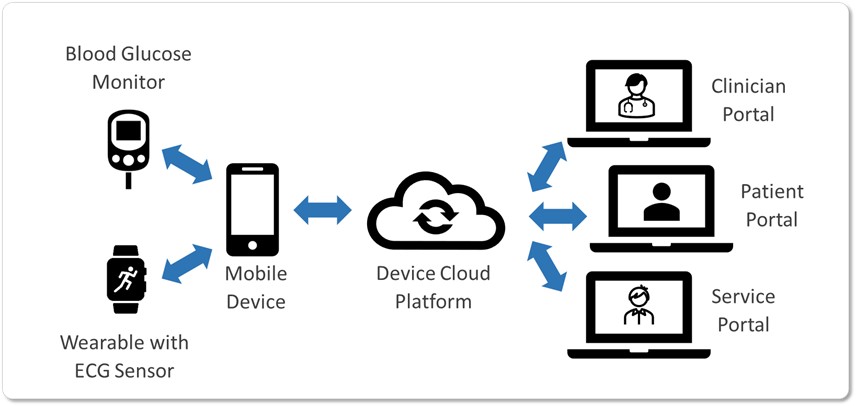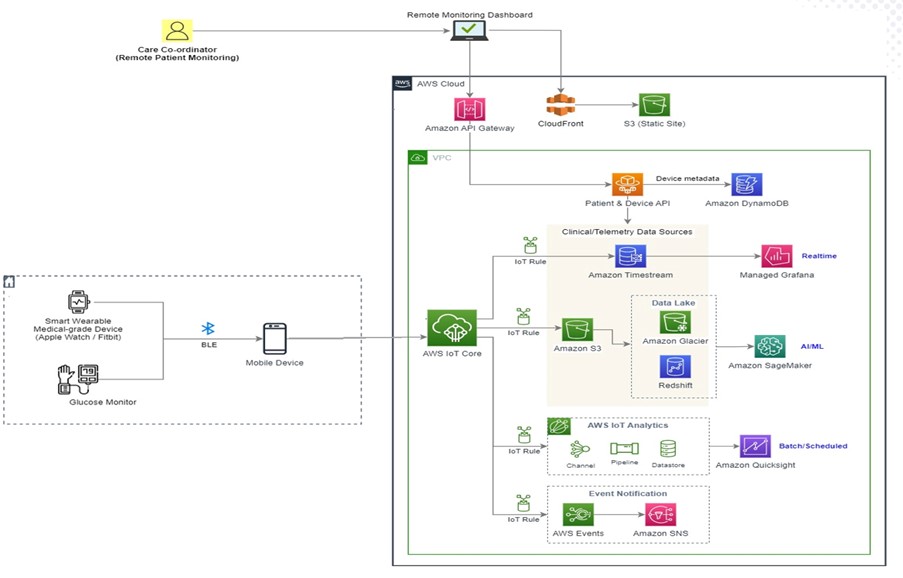Insights
- Healthcare's focus on patient-centric care emphasizes convenience, transparency, and personalization, shifting from hospital-centric to home-centered services.
- Models like "Hospital at Home" offer personalized care, transparency in healthcare costs, and seamless information exchange between patients and providers.
- Remote monitoring via smart devices enables real-time data analysis, enhancing patient care beyond hospital confines.
- A connected ecosystem integrates various medical devices for patient self-management, backed by secure portals for clinicians and device maintenance.
Patient centricity is taking center stage in healthcare, with convenience, transparency, and personalization forming its core tenets. This drives the focus on value-based care models, resulting in a seismic shift from traditional hospital-centric services to more patient-centric care delivered beyond hospital walls.
Embracing the concept of "Hospital at Home" not only pushes patient care towards personalization and convenience but also brings transparency to the costs linked with healthcare delivery. The seamless exchange of health information between patients and healthcare providers, made possible by a connected care ecosystem, enables hospital-level care within the comforts of one's home.
The nucleus of this transformation lies in establishing a robust connected care ecosystem through remote monitoring and therapy devices. By leveraging smart connected devices that stream patient monitoring data to cloud platforms, healthcare providers can analyze real-time data, generating insights crucial for patients, caregivers, and clinicians. Moreover, remote device management ensures ongoing therapy and optimal patient care, allowing clinicians to monitor and adjust device settings. In contrast, device service teams can troubleshoot issues remotely, ensuring patient safety.
Technology challenges in remote patient monitoring
To deliver exemplary remote patient monitoring solutions, MedTech organizations must address challenges in remote device connectivity and management:
- Legacy device connectivity: Constructing connectivity modules compatible with legacy medical devices facilitates data exchange with clinical systems and cloud-based monitoring platforms.
- Standardizing data formats: Transforming native data exchange formats to industry standards like FHIR ensures seamless data consumption across major cloud service providers.
- Firmware updates and device breakdowns: Rigorous automated testing of firmware updates before deployment and enabling preventive device maintenance to mitigate potential connectivity issues and reduce servicing costs.
Regulatory Compliance and Security: Staying abreast of cybersecurity guidelines and regulatory mandates ensures device safety and compliance with regulations like FDA, MDR, and IMDRF.
Remote monitoring ecosystems for patients on the move
Medical devices for remote patient monitoring can vary depending on the patient's condition. Such devices include BP monitors, blood glucose monitors (BGMs), pulse oximeters, and weighing scales.
Let's take the example of John Doe, a type 2 diabetes patient discharged post an arrhythmia episode. John requires ongoing monitoring at home for arrhythmia while also managing diabetes.

Exhibit 1 – Remote monitoring ecosystem for patients
To help John his care team assisted him in setting up a diabetes management app on his phone. They provided him with a Blood Glucose Monitor (BGM) device that checks his glucose levels every few hours while a wearable device tracks his ECG readings in near real-time to detect any arrhythmias. Both devices synchronize data with John’s mobile device.
The diabetes management app is linked to John’s Electronic Healthcare Records (EHR) system, allowing him to access his medical history and medication regimen easily. With the BGM, John can track his glucose levels at home and adjust his medication dosages as needed. The wearable device tracks John’s heart rate, sleep, and activity levels, providing valuable data for his care team to monitor his arrhythmia and overall health.
John's care team can remotely monitor his health data using a secure Clinician Portal. They can view his glucose levels, medication adherence, and activity levels and adjust his medication dosages as necessary. The team can also communicate with John via the Patient Portal or through virtual visits to address any concerns or questions he may have about his diabetes or arrhythmia management.
In the background, device manufacturers ensure both the devices are online and using the latest firmware. Service technicians can manage devices by pushing updates through the Service Portal.
The mobile devices sync data with a cloud-based platform that acts as the mobile app's backend. This platform analyzes the data and generates insights for clinicians, patients, and device manufacturers. Clinicians can track glucose variability over time and adjust medication dosages as necessary.
They can also detect any irregular heart rhythms to check cardiac health, track medication adherence and physical activity, and generate prompt alerts to prevent clinical events. On the other hand, device manufacturers can monitor BGM and wearable device usage over time, track device status trends (such as connectivity, battery, and utilization), assess glucose test strip needs of patients based on their usage, identify patients who are not using the devices or app and are likely to churn and evaluate potential up-selling/cross-selling opportunities.
To build a connected ecosystem of devices for John’s home care, his care team can use an AWS (Amazon Web Services) reference architecture for connected devices at home.

Exhibit 1 – Remote monitoring ecosystem for patients
The key components of the connected devices ecosystem at home include:
- Streaming data ingestion from medical devices to the cloud: Home medical devices, such as BGM and wearable ECG devices, typically connect to a patient’s mobile device via Bluetooth. The patient’s mobile device then syncs the device data and connects to AWS using a VPN or internet.
- Cloud-based device platform: Telemetry data from medical devices is sent to AWS IoT Core using MQTT / HTTPS protocol. Amazon DynamoDB is used to store device information, metadata, and security certificates. Medical device data is then stored in Amazon S3 buckets, and device metadata can be linked with device data in S3. Historical analytics can be performed on device data stored in Amazon Timestream. AWS IoT Events can be used to detect events and generate alerts for patients and caregivers.
- Clinical and operational insights generation: AI/ML models can be applied to S3 data using Amazon SageMaker. Amazon QuickSight can then display visualization insights for clinicians, patients, and service team members.
When building a connected devices ecosystem for patient care at home, it's crucial to prioritize patient data security and privacy. Apart from the building blocks of the connected device ecosystem, it's necessary to implement security and privacy controls on the cloud, medical devices, and mobile apps. This approach ensures that patients' personal and medical information is kept confidential and secure
Way forward
The evolution of personalized remote healthcare heralds a new era in healthcare, moving care delivery from the confines of hospital walls to patients' doorsteps.
By enabling device connectivity for smart medical devices, we can enhance remote monitoring of patients at home and drive the transition of care outside the traditional care setting. Eventually, patients' quality of life is expected to improve, and the cost of care will be reduced by focusing on wellness and preventive care rather than reactive and urgent care. Eventually, remote patient monitoring through connected devices can help improve clinical outcomes, reduce hospital visits, and enhance patient safety. Coupling remote patient monitoring with telehealth will help deliver superior care to patients and enable value-based care outside traditional hospital care. Besides clinical benefits, there are incentives for physicians to provide remote monitoring services to patients. Opportunities exist for MedTech organizations to tap into these incentives by supplying value-added remote monitoring solutions to physicians.
As these technologies mature, the future promises a paradigm shift in patient care, unlocking a realm of possibilities beyond the traditional horizons of healthcare.






.png?width=1920&height=1080&name=Consulting2_Menu_1%20(1).png)



























































.webp?width=400&height=400&name=The%20future%20of%20Healthcare%20(1).webp)





















.png?width=400&height=400&name=7-Jun-13-2025-02-27-19-6568-PM%20(1).png)







